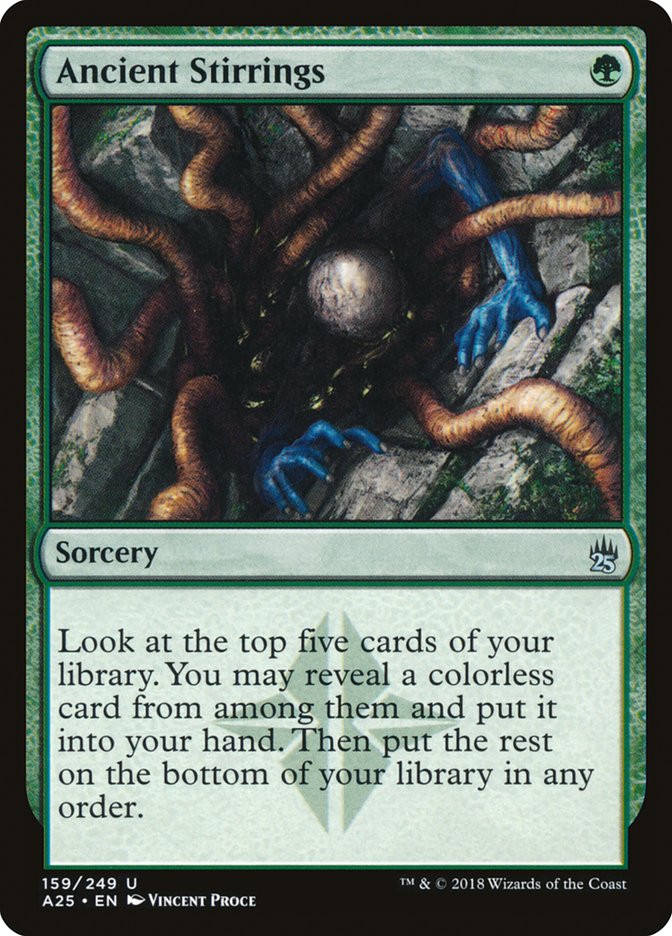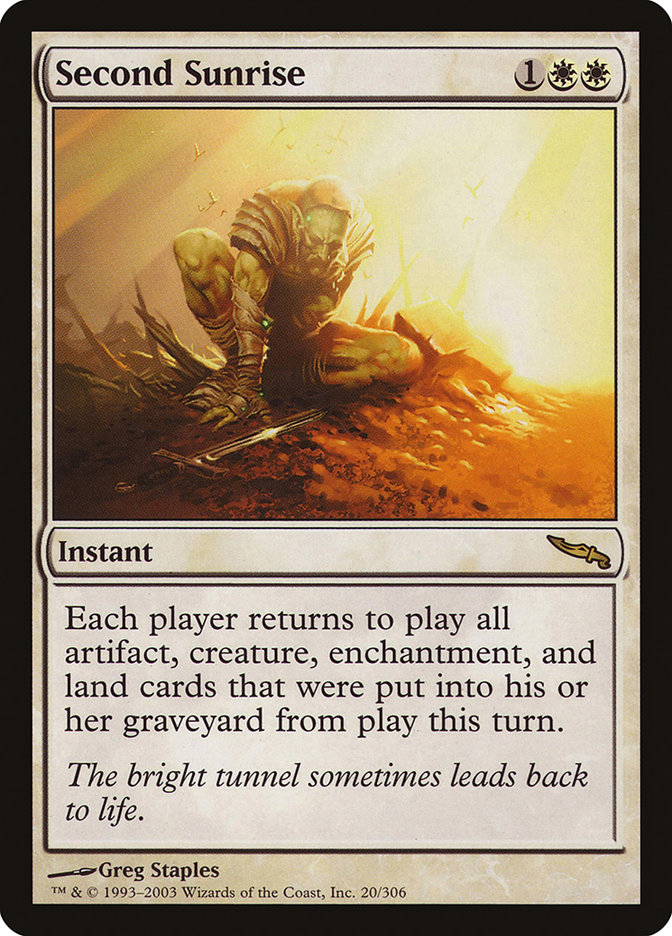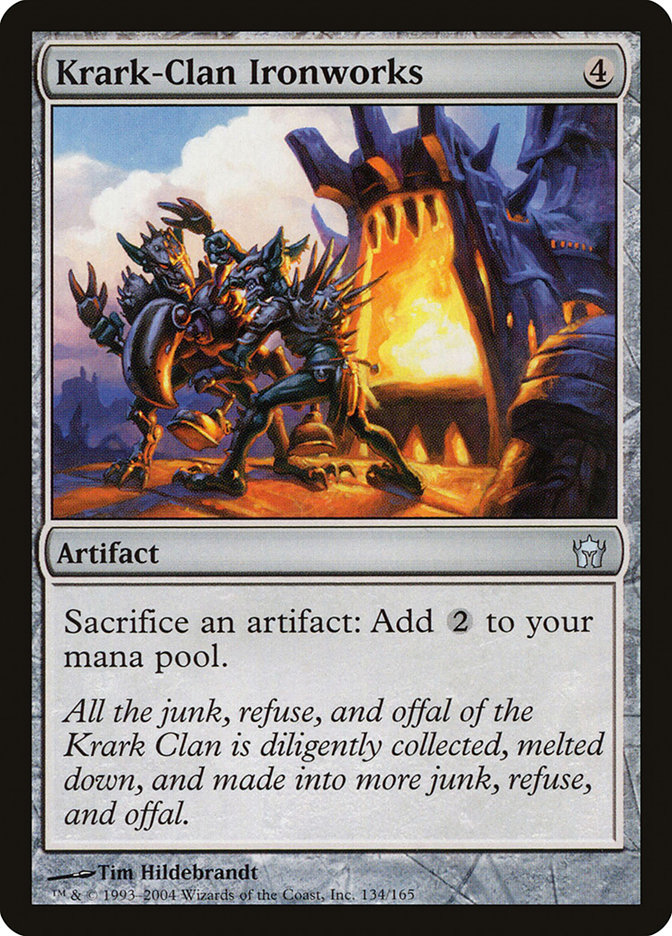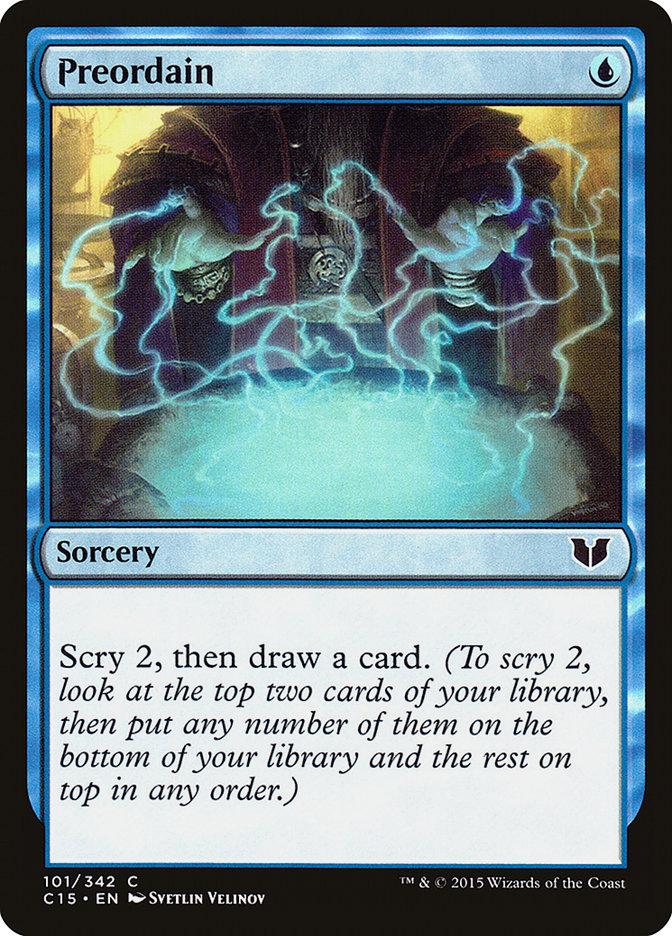Today, Sam Black made the case that Ancient Stirrings is a positive element
of the Modern format. It’s my goal to convince you that Sam is wrong and
that Ancient Stirrings is nothing more than a harbinger of misery. Frankly,
I’m tired of spinning my tires with Serum Visions while decks with easy to
navigate color requirements get access to what very often amounts to a
one-mana Demonic Tutor.
Ancient Stirrings is currently played in several Modern decks. Mono-Green
Tron, Amulet, Lantern,
Ben Ragan’s build of Affinity
, green-based Eldrazi decks, Ironworks, and presumably some number of
fringe decks beyond that. This lineup is lousy with archetypes that players
love to complain about, largely due to most of them generating games that
can often feel like Solitaire. Fun is difficult to argue though, and
according to some fun is zero-sum, so we’ll shelf that notion for now.
Sam’s support of Ancient Stirrings is largely based on the card directly
adding diversity to the format. While that is somewhat true, I would argue
that only one or two of these decks actually become non-functional with the
removal of Ancient Stirrings.
Both Tron decks and Eldrazi decks can already get a lot of their
consistency off the back of Expedition Map. Colorless Eldrazi decks don’t
touch Ancient Stirrings, and Blue Tron or potentially a powered down
version of Green Tron, could function without Stirrings. These decks might
be weaker, though I don’t think I’m alone in being okay with the format
having fewer turn three Karn Liberateds or running Thought-Knot Seers.
Lantern Control’s survivability is more of an unknown, though recent
updates such as Whir of Invention add to the deck’s consistency and I won’t
shed a tear if Lantern players must cast Serum Visions like the rest of us.
Jody Keith’s U/R Prison deck from the Modern Classic in Dallas back in
March offers a nice framework for Ensnaring Bridge decks without Ancient
Stirrings, and I’m certain there are other ways to configure similar
strategies. I’m inclined to believe that Ironworks can adapt in much the
same way.
Planeswalkers (1)
Lands (23)
Spells (36)
- 4 Ensnaring Bridge
- 1 Crucible of Worlds
- 1 Artificer's Intuition
- 1 Tormod's Crypt
- 4 Chalice of the Void
- 1 Welding Jar
- 2 Engineered Explosives
- 1 Pithing Needle
- 1 Bottled Cloister
- 4 Mishra's Bauble
- 3 Expedition Map
- 4 Mox Opal
- 1 Witchbane Orb
- 1 Grafdigger's Cage
- 1 Ghirapur Aether Grid
- 4 Whir of Invention
- 2 Sorcerous Spyglass

The deck that is most likely to be a full-on casualty of an Ancient
Stirrings ban is Amulet. Amulet players understand their deck much better
than I do, so I may just be wrong here, though I’m not sure how to fix the
issue of having significantly lowered access to the deck’s namesake card.
That said, I’m not sure that Amulet is a deck that’s worth going to bat
for. The strategic complexity of the deck is something to be admired,
though the deck is heavy on elements that leave your opponent to just sit
back and watch you play in many of the games in addition to being pretty
inaccessible to most players. With apologies to Matthias Hunt, I don’t have
much empathy for his darling.
Beyond all this though, I believe that Ironworks has become something of a
problem in the Modern format. More and more voices are proclaiming that the
deck is more resilient than one might think, and resilient combo decks by
their nature lead to non-interactive games of Magic. High access to
Engineered Explosives and the value generated by Scrap Trawler allow the
deck to shake off many angles of attack. These sins aren’t all that
different from those of Splinter Twin.
This weekend while covering the Worcester Open there was a window between
rounds in which we got word that a player was in the middle of a judge call
in extra turns playing Ironworks. When you get that information, there’s
really no way of knowing when the next round will start. The feeling I got
when hearing this was all too reminiscent of Second Sunrise.
While Ironworks is a deck that does present a loop at some point on its
combo turns, imprecise execution and awkward draws lend the deck to
generating some unnecessarily long games with a higher degree of frequency
than I’m comfortable with. When a deck causes logistical issues in
tournaments, it’s a much bigger deal than negative individual game
experiences, as this also detracts from the experience of other players in
the tournament, staff working the event, and for tournaments being
broadcast, even the viewers at home. The deck commits so many game actions
on its combo turns that a player’s dexterity actually ends up being tested
in timed rounds. I’ve legitimately gotten dizzy watching some players play
the deck. Tournament Magic should not punish players based on their or
their opponent’s actions per minute.
The deck is definitely beatable. Exploitable even if it gets too popular.
Graveyard hate and Stony Silence tend to be great against the deck.
Excellent and consistent tournament finishes like
Matt Nass
‘s pair of
Grand Prix wins
and Zac Elsik’s finals appearance at the
Season One Invitational
this year ultimately carry more weight in the conversation than the
theoretical notion of “beatability” from my perspective. I’ll grant that
these finals appearances are perhaps Ironworks over-performing, but only
slightly. Even when Ironworks isn’t winning the tournament outright you
will still find it peppered in tournament results among the top finishing
decks. Two of the top 16 teams from the
Worcester Open
this weekend had an Ironworks player in their Modern seat, and the
Modern Classic results
mark another Top 8 and Top 16 finish.
I’m not looking to make a sweeping declaration about any sort of format
dominance, my position here is that Ironworks has staying power in the
format and its presence in the field presents logistical issues that
negatively impact tournament experiences. These things, historically, tend
to lead to cards getting banned. Naturally players don’t like it when cards
are banned, and ban decisions should not be made lightly. The following is
my short list of candidates in the discussion and my thoughts on each.
I’ve seen calls for the banning of the deck’s namesake card, which is a
fine place to start the conversation. Ironworks is the card that makes the
engine run, after all. The appeal of banning Ironworks itself would be that
you don’t take anything away from other decks. Bans with few cascading
effects are attractive in that a larger percentage of players get to
continue playing their decks without having to make any changes and it’s
relatively easy to predict the impact such bans would have on the metagame
at large.
The downside is that your banlist now contains a four-mana card that can
only be cast at sorcery speed. There are plenty of things that a player can
do to beat cards of this nature in a format as wide as Modern, to the point
that the four-mana card is basically never the actual problem. Bloodbraid
Elf and Jace, the Mind Sculptor were just unbanned, after all. Their
unbanning and tame presence in the format is a good lesson about the power
level the format can sustain in the four-mana slot.
Krark-Clan Ironworks as a card is only playable in the context of a very
specific framework. Your deck needs to be stacked with cheap artifacts,
which generally means that your deck is stocked with a lot of air. Ichor
Wellspring is an important part of the deck, but as a singular card is a
do-nothing that you’re required to play. The restrictions that Ironworks
places on a player and the wonkiness of the card are both things that are
cool to see in tournament Magic. Meanwhile, the legality of some of the
other cards in the deck are of a somewhat dubious nature.
I’m not going to mince words here, Mox Opal is on borrowed time. Moxen have
a storied history of degeneracy, and cheating on mana is a consistent
thread in the Modern banlist and the banlists for other formats as well.
Chrome Mox has never been legal in Modern, and the concern with regard to
fast mana enabling combo decks and the oppressive impact these decks have
on Constructed formats has been borne out time and again. I’ve long held
the position that whether to ban Mox Opal is less a matter of if than one
of when.
Despite being a mainstay in a deck that I believe to be a problem, I would
still say that the answer to this question of when is “not now.” Modern is
always going to have a handful of cards that are definitely too good to see
print by whatever the current design philosophy is, and having some busted
effects in the format is even desirable. Playing a bunch of cards on the
same turn is fun, and you want the format to offer a variety of powerful
effects.
The reason that Mox Opal is currently given a pass is that Affinity is a
deck that many players are invested in that offers interesting gameplay in
an easily exploitable strategy. Artifact hate can be backbreaking for
Affinity, and even just having a high volume of spot removal can stop the
deck in its tracks. Not to mention that extremely maindeckable cards like
Kolaghan’s Command and Electrolyze offer pre-sideboard “hate” for this
strategy. Mox Opal will be banned one day, though it’s unlikely to be
because of Affinity.
The alarm bells for Mox Opal have actually sounded relatively recently when
Sram, Senior Edificer entered the format. The functionally similar
Puresteel Paladin in conjunction with a grip of zero-mana equipment enabled
a deck that sometimes was able to win on the second turn of the game with a
lethal Grapeshot. As we know now, the deck ended up being too much of a
glass cannon to be a mainstay of the format, which allowed Mox Opal fans to
rest easy for now. The deck, while capable of some broken draws, simply
lacked the consistency to compete in longer tournaments.
Modern decks are allowed to be too powerful some of the time. The problem
tends to be when they do their broken thing too consistently.
The Modern banlist already has a handful of cards that are too good in the
card selection department, and an Ancient Stirrings ban wouldn’t be
anything terribly surprising given that when you boil it down it is simply
an efficient card selection tool. Further, many Modern bans have been made
with the idea of weakening decks rather than eliminating them outright. I
made the case earlier that banning Stirrings would do more to change the
way some decks are built rather than render them completely unplayable,
which is going to be the desired goal when banning cards.
Sam argues that the deckbuilding parameters of Ancient Stirrings cause the
consistency that it adds to be a feature of linear decks, and an
exploitable one at that. I would argue first that the range of cards that
Stirrings finds is actually so wide that it makes interacting with
Stirrings decks considerably more difficult. Being able to find creatures,
artifacts, lands, and a small array of planeswalkers already means that a
resolved Stirrings will result in the opponent needing to answer a pretty
varied assortment of problems. Ironworks may not take all that much
advantage of this feature, but Tron decks looking for lands or finishers is
pushing some boundaries and Eldrazi decks grabbing Cavern of Souls is
something Stirrings does that works to reduce counterplay.
The other counterpoint to this argument is that Stirrings is capable of
drumming up cards that disrupt your opponent. One of the cogs of Ironworks
is Engineered Explosives, which can be used both to blunt opposing
proactive strategies in addition to serving as counter-hate against cards
like Rest in Peace. Tron being able to Stirrings into Walking Ballista is a
recent update to the format that has had a pretty dramatic effect on some
of the deck’s worst matchups, allowing the Tron player to laugh off
formerly problematic cards like Blighted Agent. One of the really quirky
things about the Modern format is that Blood Moon, a card that should
generally be excellent against decks relying heavily on non-basic lands, is
actually pretty bad against Tron. This is in no small part due to Tron’s
inflated access to Oblivion Stone granted by Ancient Stirrings.
There’s a greater conversation happening right now about Modern that
centers around many players wanting the Modern ban list to be as short as
possible. There have been a number of successful unbannings in recent years
that were met with a lot of skepticism until we saw them play out. The more
of this that has happened the more I’ve found myself in this camp, though
there is one common line of thought on which I diverge significantly.
A card that frequently comes up in these discussions is Preordain. The most
legitimate argument in favor of Preordain is that Ancient Stirrings is
legal and is simply much better at what it does. If I believed that the
restrictions that Ancient Stirrings placed on deckbuilding offered
legitimate weaknesses this would be a great counterpoint, though as I have
argued, the range of cards that Stirrings can hit is simply too wide at
this point. Not to mention that Stirrings only gets better as more and more
efficient colorless cards are added to the format; an inevitability due to
Modern being a non-rotating format. As such, the declaration that I would
like for the Modern banlist to make is not that both Preordain and Ancient
Stirrings are fine with a Preordain unban, but rather that the decision to
ban Preordain was spot on and that Ancient Stirrings is wrong for the
format for the same reasons.
In summary, Ancient Stirrings should go because:
-
The diversity generated by Ancient Stirring’s legality is
exaggerated -
The range of cards that Stirrings can find is too wide to
categorize the card as an innocent enabler of linear strategies -
Having Preordain be banned while having Ancient Stirrings legal has
somewhat bizarre optics, and I firmly believe that both are too
good and lead to gameplay that is too redundant








